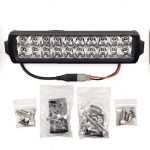It’s something that confronts everyone who mows a lawn. What do you do with grass clippings? The issue can actually influence the type of accessories you buy with the lawn mower.

(Courtesy: John Lee at flickr.com)
Many who prefer clean results when mowing the lawn may decide to include a grass catcher with their lawnmower purchase. That is not necessarily a necessity. You can cut your lawn and allow the grass clippings to stay where they fall or you can save the clippings that end up in the grass catcher and add them to your compost pile or use them as natural mulch
Believe it or not, there are benefits to leaving clippings on the yard. They decompose quickly, offering nutrients to the soil and encourage the grass to grow well because they add nitrogen to the soil.
Some people may not like the idea because the leftover clippings make the yard look untidy to them.
If you are one of those people, then including a grass catcher with your lawn mower is indeed a necessity. However, you don’t have to throw the clippings away. There are other ways to use them.
Here are some options.
- Add the grass clipping to your compost pile. Grass adds valuable nutrients including nitrogen to the compost mix.
- Use the clippings as natural mulch. Pile them up in the garden around flowers or vegetables. They hold in water, keep the soil warm, and helps to eliminate weeds. However, it is suggested that you don’t lay them on too thick.
- Turn the clippings into the soil to prepare it for a garden.
Grass Cycling
If you decide to leave the clippings on the lawn, then you need to be aware of grass cycling.
Grass cycling starts with assuring that the blades on your mower are sharp.
Next, you need to be aware that you have to mow your lawn more frequently. This prevents the buildup of excess clippings that will take too long to compost and cause a smelly mess originating from the top of the grass.
In order to grass cycle, you need to cut no more than one-third of a blade of grass. The best length of clippings you intend to cycle are 2-inches to 2-1/2-inches per blade. It is also recommended that you mow your lawn every five to seven days to produce clippings that will compost into the lawn quickly.
It is also suggested that you mow when the grass is dry. This ensures that the mower is able to chop the grass, cause less stress to the grass, and prevents clumps. Don’t scalp your lawn and mow at the proper height for your grass species. In the summer you can let the grass grow a little longer to prevent moisture stress.
If it has been too wet to mow frequently, then mow over the clippings again, then rake them into the root zone of the grass. Don’t permit clippings to gather on non-porous, inorganic surfaces like sidewalks and driveways. Instead, use a snow blower or sweep them off the sidewalks and driveway. This avoids them from being washed into waterways.
Be aware that it’s best not to recycle clippings that have grown too long or is too wet when you mow. The clippings could clump together and harm growing grass.
In addition, don’t recycle if the grass has a disease or has been recently sprayed with weed killer. In this case, use the grass catcher when you mow or otherwise bag them and leave them at the side of the road with yard waste to be removed.
Source: gardeningknowhow.com






